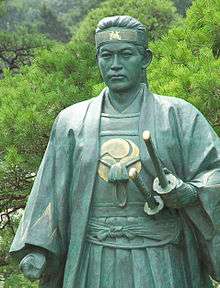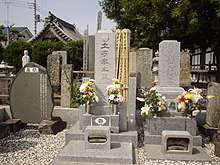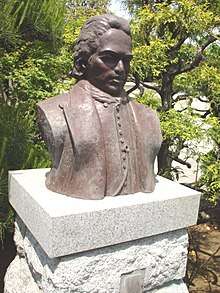Hijikata Toshizō
| Hijikata Toshizō Yoshitoyo | |
|---|---|
 | |
| Native name | 土方 歳三 義豊 |
| Other name(s) | Naitō Hayato |
| Nickname(s) | Oni no fukucho (鬼の副長 Demon Vice-Commander) |
| Born |
May 31, 1835 Ishida, Tama, Musashi Province, Japan |
| Died |
June 20, 1869 (aged 34) Hakodate, Hokkaido, Japan |
| Buried | unknown |
| Allegiance |
Tokugawa Shogunate |
| Service/ |
Rōshigumi (former) Mibu Rōshigumi (former) Shinsengumi |
| Years of service | 1863–1869 |
| Rank |
Vice-Commander Assistant Army Minister |
| Battles/wars | |
| Relations |
Hijikata Yoshiatsu (father) Etsu (mother) Hijikata Tamejiro (brother) Hijikata Kiroku (brother) Hijikata Shuu (sister) Kasuya Ryojin (brother) Satō Nobu (sister) Satō Hikogorō (brother-in-law) |
Hijikata Toshizō (土方 歳三, May 31, 1835 – June 20, 1869) was the Japanese Vice-Commander (副長 Fukucho) of Shinsengumi, a great swordsman and a talented military leader who resisted the Meiji Restoration.
Background
Hijikata Toshizō Yoshitoyo (土方 歳三 義豊) was born on May 31, 1835, in the Ishida village, Tama region of Musashi Province (present day Ishida, Hino), Japan. He was the youngest of six children (later records discovered in recent years revealed that he was actually the youngest among the ten children), and his father Hijikata Yoshiatsu (Hayato), a well-to-do farmer, died a few months before his birth. His eldest brother Tamejiro, was born blind and as a result, could not inherit the family property. His 3rd older brother Daisaku (later Kasuya Ryojin), was adopted to another family and would later became a physician. His eldest sister Shuu died when he was about three years old and his mother Etsu also died when he was six years old, and he was therefore raised by his 2nd older brother Kiroku and sister-in-law.
He was apparently tall compared to the average Japanese men of the period, and it is said that he was very handsome. He was said to be spoiled at an early age and was alleged to be mean to all but his friends and family. This changed when a 21-year-old swordsman from the Aizu clan known for opposing the Reformists was forced to commit seppuku. When Hijikata attended the man's funeral, he apparently cried in public.
Hijikata spent his youth selling his family's Ishida sanyaku (medicine for treating injuries such as bruises and broken bones) while practicing his self-taught kenjutsu. His brother-in-law, Satō Hikogorō, who was married to his older sister Nobu, managed a Tennen Rishin-ryū dojo in Hino; through Satō, Hijikata later met Kondō Isami and was formally enrolled at the Tennen Rishin-ryū's Shieikan in 1859. Although Hijikata himself never fully mastered the Tennen Rishin-ryū, it is said that he managed to develop the "Shinsengumi-Kenjutsu" fighting style from the Tennen Rishin-ryū.
An arrangement was made by his eldest brother Tamejiro for him to marry Okoto, the daughter of the shamisen shop owners. Since he had already planned to join the Rōshigumi with Kondō Isami, Hijikata told them that after he got a promotion, he would carry out his marriage.
Shinsengumi period
In 1863, Hijikata and Kondō Isami joined the Rōshigumi in Edo, they arrived in Mibu, Kyoto and remained there as the Mibu Rōshigumi while the rest returned to Edo. Later, when Mibu Rōshigumi was renamed as the Shinsengumi, Kondō and two other men, Serizawa Kamo and Niimi Nishiki, became joint leaders of the group, and Hijikata served as one of the deputy leaders. Shinsengumi served as a special police force in Kyoto that fought against the Reformists under Matsudaira Katamori, the Daimyō of Aizu.
However, Serizawa and Niimi began fighting, drinking, and extorting money from merchants in Kyoto, which started to tarnish the reputation of Shinsengumi and earned the group the derogatory nickname of "Wolves of Mibu" (壬生狼 Miburō). Hijikata found enough proof against Niimi in these matters and ordered him to commit seppuku in October 19. Later in October 30 (or October 28) at night, Hijikata and the selected Shinsengumi members went into the house of Yagi Gennojō and assassinated Serizawa, his woman Oume, and one of his followers Hirayama Goro, with Hirama Jūsuke been the only survivor fled that night. Kondo became the sole leader of Shinsengumi, with Yamanami Keisuke as his Vice-Commander.
Some time after the Zenzaiya incident, Yamanami Keisuke tried to leave Shinsengumi, despite the regulation against deserters. As a result, he committed seppuku with Okita Sōji as his Kaishakunin on March 20 (lunar calendar February 23), 1865; and Hijikata took over as Vice-Commander. Due to his position in the Shinsengumi, which would be dangerous for anyone close to him, Hijikata felt that he had no choice but to cancel his marriage engagement with Okoto. Although he later had many lovers, he never came close to making a commitment to any of them.
The Shinsengumi grew to 140 men, which included a number of farmers and merchants whose livelihood would be threatened if the Tokugawa shogunate was overthrown. The regulations set up by Shinsengumi within Kyoto were strict and Hijikata was known to be harsh in enforcing them, hence his nickname: Oni no fukucho (鬼の副長 Demon Vice-Commander). Even within the Shinsengumi itself, regulations were strictly enforced by Hijikata. As usual, deserters and traitors were forced to commit seppuku.
Hijikata owned, among others, a sword signed "Izumi no Kami Kanesada" (和泉守兼定), made by the 11th and last generation Aizu Kanesada (1837-1903).
Together with the rest of the Shinsengumi, Hijikata became a Hatamoto (旗本) in 1867 and took the name of Naitō Hayato (but reverted to his original name after Kondō was captured and executed during the Boshin war).[1] He was given the rank of Yoriai (寄合格 Yoriai-kaku) in early 1868.[2]
Boshin War

Following the Boshin War in 1868, Kondō and Hijikata led the Shinsengumi in their final battles against the new government and fought in the Battle of Toba–Fushimi in January 1868. The Shinsengumi returned to Edo and was later reformed into a unit known as the Kōyō Chinbutai (甲陽鎮撫隊 Pacification Corps) and departed from Edo for Kōfu Castle in March 24 upon orders to suppress the uprisings there. But while on the way there, they received news in March 28 that the Kōfu Castle was taken by Imperial Court forces led by Itagaki Taisuke and later settled at a town of Katsunuma five miles east of Kōfu.
In March 29, 1868, Kondō, Hijikata and the Kōyō Chinbutai resisted an attack by the Imperial forces at the Battle of Kōshū-Katsunuma for about two hours but lost, and they were scattered and fled to Edo.
In April 11, 1868, Kondō, Hijikata and the Kōyō Chinbutai departed Edo again and later set up a temporary headquarters at the Kaneko family estate, northeast of Edo. They later moved to a new headquarters in Nagareyama in April 25, 1868.
During the training at Nagareyama in April 26, 1868, the Kōyō Chinbutai were caught by surprise by the 200 strong Imperial forces led by Vice-chief of Staff Arima Tota of Satsuma Domain and Kondō was ordered to go with them to their camp at Koshigaya. He was later brought to Itabashi in April 27, 1868 for questioning. On the same day Hijikata went to Edo to see Katsu Kaishū and asked for his help in getting a pardon for Kondō. On the following day, a messenger arrived at Itabashi with a letter seemingly written by Katsu requesting that Kondō's life to be spared, but the messenger was arrested and the request was denied.
Following his trial in April 31, 1868, Kondō was executed at Itabashi execution grounds in May 17, 1868. Hijikata, convalesced from a foot injury sustained at the Battle of Utsunomiya Castle, brought Kondo's hair to Aizu and was said to have personally supervised the erection of Kondo's grave memorial at Tenneiji Temple.
Following the Battle of Bonari Pass, the next day in 7 October 1868, Hijikata met Saitō Hajime at the Inawashiro Castle and stayed at the Saitoya inn in Wakamatsu. When Hijikata decided to retreat from Aizu, Saitō and a small group of Shinsengumi parted with Hijikata and continued to battle in the Battle of Aizu until the very end. Hijikata and his rest of the Shinsengumi went to Sendai, where he joined up with Enomoto Takeaki's fleet.[2]
He knew he was fighting a losing battle, and told the physician Matsumoto Ryōjun:
I am not going to battle to win. With the Tokugawa government about to collapse, it would be a disgrace if no one is willing to go down with it. That is why I must go. I will fight the best battle of my life to die for the country.
In October 1868, Hijikata and Ōtori Keisuke led Shogunate forces to occupy the fortress of Goryōkaku in the Battle of Hakodate, and continued to eliminate local resistance. When the short-lived Ezo Republic was founded in December, Hijikata was made a vice-minister of the Army.[2] Imperial troops continued to attack by land and sea.
In May 6, 1869, Hijikata led a daring but doomed raid to steal the imperial warship Kōtetsu in the Battle of Miyako Bay, in the early morning, a number of oppositionists managed to board the ship via the Kaiten warship, but Kōtetsu repelled the attack and mowed them down with a Gatling gun. Many others including the captain of Kaiten were also killed by gunfire from the Imperial ships. The battle lasted only thirty minutes, Hijikata, the survivors and the Kaiten retreated to Hakodate.
Later on the fourth week of May 1869, Hijikata led the 230 strong Republic of Ezo forces and the surviving Shinsengumi against 600 strong Imperial forces during the Battle of Futamata for sixteen hours and were forced to retreat. The Imperial forces attacked again on the next day, only to retreat. On the following night, Hijikata led a successful raid on the Imperial forces' camp, forcing them to flee. Hijikata and the forces later retreated to Hakodate in June 10.
Death
During the Battle of Hakodate, the final battle of the Boshin War, Hijikata summoned his 16-year-old page, Ichimura Tetsunosuke on June 14 (lunar calendar May 5), 1869, to a private room in an inn. There, he entrusted Ichimura with a death poem, his katana, a letter, a photograph of himself, and several strands of his hair. Ichimura was instructed to bear them to the home of Hijikata's brother-in-law Satō Hikogorō in Hino. The death poem entrusted to Ichimura reads:
Though my body may decay on the island of Ezo, my spirit guards my lord in the East.
In the final conflict of the revolution, on June 20 (lunar calendar May 11), 1869, Hijikata was killed near the Ippongi Kanmon (一本木関門) while leading his troops on horseback by a bullet that shattered his lower back. His body was later claimed by Koshiba Chōnosuke and others.
Three days later in June 23 (lunar calendar May 14), 1869, a remaining group of surviving Shinsengumi members under the last commander Sōma Kazue had surrendered at Benten Daiba. A week after his death, the Goryōkaku fortress was taken, and the military of Ezo Republic surrendered to the Meiji government on June 27, 1869, marked the end of Boshin War.
It is unknown where Hijikata was buried, but it is believed that his body was buried either at Goryōkaku, Hekketsuhi or Ganjoji.
Grave memorials and monuments
The first grave memorial of Hijikata was at Wakamatsu-chō, Hakodate, where he was killed, near the reconstructed Ippongi Kanmon in the present day compound of the Hakodate Welfare Centre.
A grave memorial of Hijikata was also erected at Sekidenji temple in Hino, Tokyo, Japan.
Other grave memorials were located at Shōmyōji (Hakodate, Hokkaido), Tenneji (Aizuwakamatsu), Jutokuji (Kita, Tokyo), Entsūji (Kita, Tokyo), etc
A monument known as Hekketsuhi , was erected at Hakodate in memory of about 800 people, including Hijikata, who died during the Boshin War.
In 1875, Nagakura Shinpachi, with the help of Matsumoto Ryōjun and several of his surviving former Shinsengumi comrades including Saitō Hajime among others, erected the monument known as the Grave of Shinsengumi for Kondō Isami, Hijikata Toshizō, and the fallen comrades of the Shinsengumi at Jutoku-ji temple boundary in Itabashi, near Itabashi Station in Tokyo.

The Hijikata Toshizō Museum was later established in 1994 near the Sekidenji temple.
In popular culture
The Shinsengumi have become a popular subject for films, television, and manga and anime, ranging from historical drama to comedy and romance. As a leader of the group, Hijikata is usually a prominent character in such productions.
Hijikata is depicted in the 1999 film Gohatto ("Taboo") (played by Takeshi Kitano) and the 2013 NHK Taiga drama Yae no Sakura (played by Jun Murakami). He was also played by Koji Yamamoto in both the 2004 NHK Taiga drama series Shinsengumi! (including the single-episode sequel Shinsengumi!: Hijikata Toshizo Saigo no Ichinichi) and 2015 Taiga drama series Asa ga Kita. He is the protagonist in Morita Kenji's manga Getsumei Seiki, and in Mibu Robin's Baragaki ("Red Demon").
He is also featured in a number of other anime and manga series, including Gintama (an inspired character named Hijikata Tōshirō 土方 十四郎), Peace Maker Kurogane, Bakumatsu Kikansetsu Irohanihoheto, Ghost Slayers Ayashi (as a child, with a brief glimpse of his future death); Kaze Hikaru, Shura no Toki, Hell Girl, Soar High! Isami (inspired character: Toshi Tsukikage) and the popular otome game/anime series Hakuouki: Shinsengumi Kitan. Hijikata is also a supporting character in Shin Teito Monogatari, the prequel to the bestselling historical fantasy novel Teito Monogatari (Hiroshi Aramata). In the manga and anime, Drifters, Hijikata serves as one of the antagonists, who holds hatred to the protagonist, Shimazu Toyohisa, because he is an ancestor of the Shimazu clan he fought. He is also a main character in Golden Kamuy manga drawing a lot of similarities both historically and in overall personality.
He also appears on the game Way of the Samurai 4 as an optional DLC fight, upon defeat his face, hair and uniform are unlocked on character creation.
Hijikata Toshizō appears in the 2014 historical fiction novel The Soldier and the Samurai.( ISBN 1500183059)
Toshi Tsukikage from anime series Soar High! Isami is based and inspired on Hijikata Toshizō.
He appears under the name Hijikata Toshiro in Gintama, in which he is also the vice chief of the Shinsengumi, and is nicknamed "The Demon Vice Chief".
Shinomori Aoshi, a main character from Rurouni Kenshin, is based on Hijikata. Saito Hajime, another main character based on another member of the Shinsengumi of the same name, poses as a medicine peddler selling Ishida Sanyaku in his first appearance in a nod to Hijikata's early life. Saito also talks about Hijikata in the show, claiming that there's not a single flaw in the attack move "Hiratsuki" created by "strategy genius" Hijikata, and that Saito's "Gatotsu" is better.
A 2015 otome game "Destined to Love" features Hijikata Toshizo as a possible suitor for the main character. Another otome game ©2015 Spaceout inc. named "Bakumatsu Shinsengumi" also features Isami Kondo, Hijikata Toshizo and Soji Okita as suitors for the main character.
He also appears in the game Fate/Grand Order as a Berserker-class Servant.
He also appears in the anime Katsugeki/Touken Ranbu as Hijikata Toshizo.
Notes
- ↑ 幕臣取り立て 新選組概史 歴史館-動乱の章; accessed 16 June 2015.
- 1 2 3 土方歳三 HIJIKATA, tamahito.com; accessed 16 June 2015.
Further reading
- Hijikata Toshizō and Okita Sōji. Hijikata Toshizō, Okita Sōji zenshokanshū edited by Kikuchi Akira. Tōkyō : Shin Jinbutsu Ōraisha, 1995. ISBN 4-404-02306-5.
- Itō Seirō. Hijikata Toshizō no nikki. Tokyo: Shin Jinbutsu Ōraisha, 2000. ISBN 4-404-02861-X
- Kikuchi Akira, et al. Shashinshū Hijikata Toshizō no shōgai. Tōkyō : Shin Jinbutsu Ōraisha, 2001. ISBN 4-404-02930-6
- Miyoshi Tōru. Senshi no fu: Hijikata Toshizō no sei to shi. Tōkyō: Shueisha, 1993. ISBN 4-08-748001-1 ISBN 408748002X.
- Tanaka Mariko and Matsumoto Naoko. Hijikata Toshizō Boshin senki. Tōkyō : Shin Jinbutsu Ōraisha, 1976.
- "Moe Yo Ken" ('Burn, My Sword') by Shiba Ryoutarou (http://moeyoken.blogspot.com/2009/01/1.html) Entire fictional biography of Toshizo (link no longer active)
- Hillsborough, Romulus. Shinsengumi: The Shōgun's Last Samurai Corps. North Clarendon, Vermont: Tuttle Publishing, 2005. ISBN 0-8048-3627-2.
External links
- Hino city museum (in Japanese)
- Hijikata Toshizo Archives (in Japanese)
- SamuraiWiki

